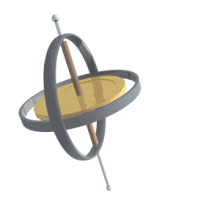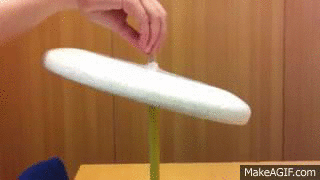The wheel is not freely spinning, unless it's spinning out.
Imagine I jump off a ramp into space and the wheel detaches from my bike, is it suddenly going to stop?
Discover new ways to elevate your game with the updated DGCourseReview app!
It's entirely free and enhanced with features shaped by user feedback to ensure your best experience on the course. (App Store or Google Play)
The wheel is not freely spinning, unless it's spinning out.
The torques stop, but the rubber wheel will spin and have some rebounding after un-compressing from the ground. A bike wheel is also spun more intrinsically while a disc is initially spun orbit-ally which will have a larger rebound from warping.Imagine I jump off a ramp into space and the wheel detaches from my bike, is it suddenly going to stop?
The torques stop, but the rubber wheel will spin and have some rebounding after un-compressing from the ground. A bike wheel is also spun more intrinsically while a disc is initially spun orbit-ally which will have a larger rebound from warping.
http://www.innovadiscs.com/discs/fairway-drivers/speed-7/teebird.htmlYou will notice the rotating gyroscope precesses and wobbles around in a cone shape like the disc images in the Innova site. When the force is applied downward the gyro nutates/wobbles in the direction of the spin downward into the cone. When the force is applied upward the gyro nutates/wobbles in the direction opposite of the spin upward into a cone. This is the same effect as the retrograde precession we consider turn vs fade when the COP is on the front or back end of the disc flipping the direction of precession mid during flight, and the wobble can flip direction as well during flight.


That's why I linked the Innova wobbler. I only used the gryo image to show direction of wobble.This is wrong. You know that a flying disc doesn't have its spin axis tied to the ground by gravity don't you? Disc wobble isn't the product of nutation, it is a product of having it's axis knocked off a right angle to it's flight plate. Like so:

That's why I linked the Innova wobbler. I only used the gryo image to show direction of wobble.
Youtube? I think it's java.Okay. I couldn't get the youtube video at work.
That's all great in theory if the disc was a rigid body. Your calculation is going to be wrong if you don't account for warping. Do you disagree with R D Lorenz?
mvp said:The three physical factors that affect a disc's performance are a combination of aerodynamics, linear momentum, and angular momentum. These three physical properties occur simultaneously to allow a disc to stay in flight.
Linear momentum is a disc's ability to maintain a forward traveling energy as a result of its mass and traveling velocity. This linear momentum is coupled with aerodynamics to allow the disc to stay in flight by means of Bernoulli's principle. Angular momentum, also known as the gyroscopic effect, is the third aspect of disc flight that is the result of a disc's rotating mass which keeps it spinning on its axis of rotation so that the disc will be aerodynamically supported in flight.
The amount of angular momentum is determined by a disc's moment of inertia. Increasing a disc's moment of inertia will increase its angular momentum and allow it to be maintained longer throughout its flight. The process of transferring mass away from the axis of rotation increases the disc's moment of inertia at parabolic proportions.
Since linear and angular momentum and aerodynamics act upon each other simultaneously, an enhanced gyroscopic effect will improve all aspects of disc flight. Increased angular momentum of a disc in flight will allow the disc to stay on its rotational axis for a longer period of time, which means that its aerodynamic properties will be better exhibited for a longer period of time.
Phases of Flight
Gyro Fade - Forward fade at spin down.
Aerodynamic Fade - Disc pulls of out turn as spin decreases.
Aerodynamic Turn - Aerodynamic profile turns the disc during the late high-speed phase
Gryo Push - Inertia carries the disc forward during the initial high speed phase
The wobble causes the disc to move left or right as the airspeed torques it.
Airspeed is a measurement of air speed. It doesn't torque anything. That's like saying cheetah speed eats gazelles. Also, torque promotes rotation, it doesn't inhibit it, and I don't see how air anything promotes rotation, unless you're talking pinwheels. Air 'resistance', for example, can act against the torque already present, but I don't see how it can promote it.
My two cents on wobble is that it causes diametrically opposite points on a disc's rim (highest and lowest) to alternately turn into and then away from the onrushing air as the disc moves through it. The result is air brake up, air brake down, air brake up, air brake down. And that's not even taking into account the disastrous airfoil this makes during all degrees of wobbled rotation. All told, the effect is to slow or stall the forward progression. It can't help but slow rotation, too, I suppose - friction is friction. If there's any validity at all to wobble contributing to left or right movement it would be because the resistance caused by the high and low points is greater on the left (RHBH) because they're rotating into the wind, than on the right because they're rotating away from the wind. Unless you can make a case for deflection in addition to drag, the effect must be to turn the disc to the left (again, RHBH) because, like a tank with a bad tread, resistance pulls a moving object in the direction towards the side with greater drag. Same thing if you try to walk a straight line dragging a cinder block tied to your left ankle - it'll turn you to the left.
Hmmm....
What are you talking about... cheetah eat gazelle speed? And disc can wobble in two different directions.Airspeed is a measurement of air speed. It doesn't torque anything. That's like saying cheetah speed eats gazelles. Also, torque promotes rotation, it doesn't inhibit it, and I don't see how air anything promotes rotation, unless you're talking pinwheels. Air 'resistance', for example, can act against the torque already present, but I don't see how it can promote it.
My two cents on wobble is that it causes diametrically opposite points on a disc's rim (highest and lowest) to alternately turn into and then away from the onrushing air as the disc moves through it. The result is air brake up, air brake down, air brake up, air brake down. And that's not even taking into account the disastrous airfoil this makes during all degrees of wobbled rotation. All told, the effect is to slow or stall the forward progression. It can't help but slow rotation, too, I suppose - friction is friction. If there's any validity at all to wobble contributing to left or right movement it would be because the resistance caused by the high and low points is greater on the left (RHBH) because they're rotating into the wind, than on the right because they're rotating away from the wind. Unless you can make a case for deflection in addition to drag, the effect must be to turn the disc to the left (again, RHBH) because, like a tank with a bad tread, resistance pulls a moving object in the direction towards the side with greater drag. Same thing if you try to walk a straight line dragging a cinder block tied to your left ankle - it'll turn you to the left.
What are you talking about... cheetah eat gazelle speed? And disc can wobble in two different directions.
Friction or resistance is anti-torque. To walk a straight line with a cinder block on one leg, you have to apply the torque to overcome the friction/resistance. The cinder block is not creating torque, it's creating friction/resistance.
The onrushing air into the disc as it wobbles around nose up torques the disc into a roll or rotation, it's lift in another direction or sailing. Wobble does also create air braking friction/drag and slows the disc's momentum, but that is different from the torque created.
What are you talking about... cheetah eat gazelle speed? And disc can wobble in two different directions.
Friction or resistance is anti-torque. To walk a straight line with a cinder block on one leg, you have to apply the torque to overcome the friction/resistance. The cinder block is not creating torque, it's creating friction/resistance.
The onrushing air into the disc as it wobbles around nose up torques the disc into a roll or rotation, it's lift in another direction or sailing. Wobble does also create air braking friction/drag and slows the disc's momentum, but that is different from the torque created.
I have always thought "high speed turn" is a result of high angular velocity. When spinning at high speeds the relative velocity of the left side of the disc and the right side of the disc are drastically different, with the left side being faster and the right side being slower. I always thought the higher velocity relative to the air was, the more lift you would generate, which is why discs turn to the right when initially thrown (this is all for RHBH). I have noticed my own OAT makes things turn to the right way more than they should, and always assumed it's because wobble enhances the effects of high angular velocity.
Is this totally asinine?